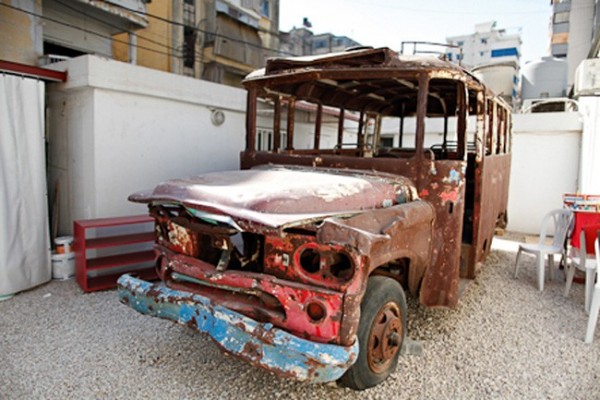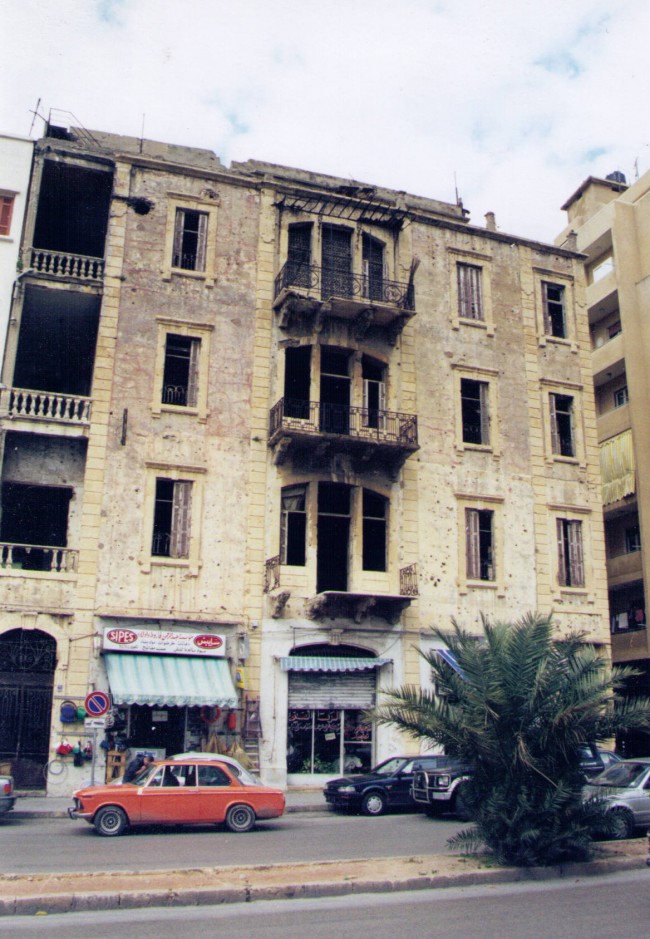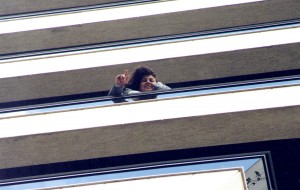
I’m hesitant to write about this yet again. Commemorations can be toxic to memory, altering it with self-indulgence or embellishment, particularly when it’s part of one’s personal history. I’ll blame my childhood friend Josyane back in Beirut. She started it a few days ago, started what every one of us Lebanese, expat or not, will be doing today and tomorrow on Facebook, in blogs, in newspaper columns: noting this date, April 13, which has as much significance for the Lebanese as Sept. 11 does for Americans, though every one of us remembers it differently. Memory’s earliest drafts owe more to prejudice or fabrication than anything like truth, which was also a casualty that day and for the 5,500 days to follow.
It was on that day 40 years ago–April 13, 1975–that the Lebanese civil war began. It would last 15 years, result in the murder of 150,000 people, demolish a nation and cause another mass exodus (of which I’d become a part three years later). It was on that day that for many of us in my generation, our childhood ended, whatever our age. I wasn’t yet 10. For a time the war seemed to rank with the Cambodian genocide as the century’s most barbaric display of inhumanity since the end of World War II, though less photogenic venues (India-Pakistan, Algeria, Eritrea), were worse. And soon enough the Balkans, Rwanda and the 21st century’s orgies of violence from the Congo to the rest of the Middle East would make Lebanon look like a warm-up act.
We didn’t know it at the time, but Lebanon was the template for a new kind of war. The post-colonial type conflicts and cold war proxies that had rained blood on four continents for 30 years were, from Angola to Indochina, mostly over. Two weeks after the first shots of the Lebanese civil war, the last helicopter flew off the roof of the American embassy in Saigon, America’s tail between its legs. The world was about to re-discover a new kind of convulsions: the sectarian war, the war driven not by conquest or ideology, but by God: Christians against Muslims, Muslims against Jews, Jews against Muslims, Muslims against Christians, and most of all, Muslims against Muslims. Europe had been there before in its Middle Ages and supposed Renaissance, that thousand years of Christian savagery–including in the New World–when the cross was no less a symbol of terror then than ISIS’ black flag is today. This was more of a return to old impulses, on new ground. A Reformation re-run, dubbed by Islam.
Lebanon was the first act, the Soviet Union’s invasion of Afghanistan the second. What would happen there would be repeated and amplified in Afghanistan, Iraq, Syria, Yemen. A destabilized government, internal divisions, sectarian clashes, uncontrollable escalations including foreign interventions, every one of which would fail.
The Soviet Union invaded Afghanistan in 1979 thinking it was implementing the usual cold war playbook a-la-Hungary ‘56 or Czechoslovakia ‘68. Invade, suppress, lock in puppet regime, get the hell out. It didn’t figure on bearded and turbaned mujahideen fanatics, al-Qaeda’s precursor, who ended the Soviet Union.
In Lebanon alone, Israelis invaded twice, the United States, France and Italy sent expeditionary forces, Syria occupied most of the country for a generation. All of them withdrew in tatters and disgrace, worsening the conflict more than taming it. Israel’s 1982 invasion of Lebanon is directly to blame for giving birth to Hezbollah and less directly, Hamas (as Israel deluded itself by thinking that it could decimate the PLO and be done with it). The United States invaded Iraq in 2003 thinking it was imposing its new world order. The imposition went the other way, triggering that nation’s Shiite-Sunni civil war and preparing the way for ISIS. It was never a winnable war. It got ugly fast. Even then American stupidity–naivete is too forgiving a word–was on display, as when George W. Bush put on his Mission Accomplished farce on the deck of the USS Abraham Lincoln at the beginning of the calamity, or when Condoleezza Rice, his secretary of state, would describe yet another Israeli invasion of Lebanon in 2006 as “the birth pangs of a new Middle East.” Some birth pangs.
Afghanistan has gone no better. We’re just stretching out the inevitable retreat there, with little accomplished and a lot more demolished, a lot more murdered. Two lost wars, $2 trillion wasted, American influence in the region a fraction of Iran’s, and Israel, that font of belligerence now led by an Abrahamic rock of arrogance and bigotry, ensuring as certainly as the region’s Islamic fundamentalists that peace is not of our time.
In so many ways, it all started that Sunday, April 13, 1975. We lived in Beirut at the time. My family and I, joined by cousins and friends, had gone for the day to our mountain home 45 minutes away in a small village called Hamlaya, where that summer we would take refuge for good as Beirut burned. My friend Josyane reminded me of particulars of that day I’d forgotten. It was to celebrate her father’s 41st birthday, the late Jean-Claude Boulos, a bigger-than-life TV personality who died three years ago. His family and mine, his three children and us three boys in mine, were one as we grew up in those balmy years when Beirut really was a Mediterranean paradise and Lebanon worth every lyricism in the Song of Songs, though it wasn’t for nothing that Solomon also called it “the lions’ dens and the mountain haunts of leopards.” The lions were there, waiting.
That Sunday, they pounced. The war’s spark has generated more conflicting accounts than the Kennedy assassination, though I found as reliable a summary on, of all places, Wikipedia. That morning Pierre Gemeyel, the leader of the Phalangist Party–a once fascist-inspired party that stood as the defender of Lebanon’s Maronite Christians–was dedicating a church in a suburb of Beirut. There was an attempt on Gemeyel’s life. He survived. Four of his militiamen did not. His party blamed Palestinian militants. Gemeyel’s militias set up roadblocks and ambushed a bus-full of Palestinians returning from a rally from one Palestinian camp, Tel el Zaatar, to another, Sabra. Some 22 people were killed in the bus massacre. Or maybe 27. Or maybe 17. I mention the two camps’ names because that day’s events was full of scriptures-like premonitions and umbilical fatalities. The same Christian militias that retaliated against the bus would end up perpetrating the war’s largest mass-massacres at Tel el-Zaatar in 1976 and, under Israeli guidance and flares, at Sabra and Chatila in 1982. The interrupted bus route had linked the two camps’ fate.

The massacre of women and children and old people, their beheading, their being smashed against walls or, when time was short, executed by machine gun, became a signature of every militia in Lebanon. Every massacre was retaliation for another. Palestinians were nowhere near innocence in all this. Refugees my ass, is how we felt about them. The Palestinian rally that day had been to “celebrate” a terrorist attack in Israel a year earlier. They too were about to turn Lebanon into their playpen of brutality. We Christians hated them. We despised them. We considered them sub-human. We idolized the Christian militias, not wanting to realize that they were cut of the same cloth. In war we put our prejudices on pedestals the better to worship them, and to pick out for persecution whoever doesn’t, though Lebanon had always treated Palestinian refugees like animals, and still does. It’s an Arab reflex.
All of that was ahead of us yet that Sunday when, according to my friend Josyane, news of the shooting somehow made it to our mountain get-away–this was not only in the days before cell phones and internet, but in the days when we had no phone in our mountain retreat. By then Beirut’s skyline was already being crisscrossed with rocket and mortar attacks and snipers, the most cowardly ground scum of any war, were beginning to scout their favorite rooftops and making pink mist of whatever moved. (Only in America, a nation with an amoeba’s awareness of war’s reality, could a hero be made of a mass murderer as Chris Kyle was in “American Sniper.”)
We packed up in a hurry and drove into Beirut. Our parents’ radar for danger hadn’t yet been unpacked. They had no clue. We had no clue that we could have run into one of those sudden militia roadblocks where men and women’s fates hung by the religious denomination on their identity papers, depending on where they were in the city: Christian heads were lopped off at Muslim checkpoints, Muslim heads were lopped off at Christian checkpoints. We got lucky. We saw for the first time what would become the on-and-off norm of deserted streets. Or else we saw improvised roadblocks of our own side’s young men. Les jeunes gens, as the deceiving euphemism for these goons went. Young men who could have been some of our older brothers’ classmates the week before, now armed to the teeth and acting the assholes they were. The dead of night was not an expression that evening. The shooting began to spread and got much worse over the following week. Our house was on Damascus Road, what would become known as the Green Line dividing East and West Beirut, Christian from Muslim, dumb from dumber.
We began learning terror that week, praying our Christian prayers with our Muslim neighbors downstairs and their Muslim prayers with ours upstairs–they were our landlords–though I was still not old enough to grasp the extent of the danger we were in. I’d have three more years to learn, three years that accounted for almost half the 15 years’ death toll. I left in 1978.

)
I was glad to be rid of the place at first. As I’ve gotten older, as almost all the adults who were with us that Sunday in the mountains–my parents, Josyane’s parents, my cousins Philippe and Danielle’s father, Georges–have died, my longing for the old country has grown sometimes intolerably and inexplicably without diminishing my attachment to my new land. Longing, like love, isn’t a zero-sum game. It overtakes and piles on, and with age it becomes part of what ages us even more. Our wrinkles are memories digging their epitaph on our skin, though what I miss is certainly not what’s there now, not even what was ever there. “The country whose absence saddens me and preoccupies me,” the great Lebanese writer Amin Maalouf wrote in his last book, “isn’t the one I knew in my youth, it’s the one I’ve dreamt about, the one that never saw the light of day.” ( “Le pays don’t l’absence m’attriste et m’obsède, ce n’est pas celui que j’ai connu dans ma jeunesse, c’est celui don’t j’ai rêvé, et qui n’a jamais pu voir le jour.”)

So it’s been, going back to that April 13th, locus of that obsession for me and my generation. We’ll never be rid of that day, though as ironies go, this one satisfies: the region all around Lebanon is now in flames. Most of Lebanon’s borders are with Syria, where it’s either ISIS or its secular twin, Bashar el Assad. Israel’s trigger-happy chronic invaders are to the south. The Arab Spring started as an anthem and turned into a joke. Every other country in the Greater Middle East is either a basket-case of oppression or a cauldron of civil unrest or outright war. Lebanon is quiet. It’s even peaceful, and diverse as ever: its leading newspaper features a sex columnist, for god’s sake. It’s not ideal there. Divisions remain. So do resentments:homo habilis was born at Olduvai, but hotheads were born in Lebanon. But that 1991 peace pact among religious tribes is holding. Neighboring countries’ bedlam may be strong caution, though memories of the war, despite its remove, are still strong enough to scare the shit out of out every Lebanese, young or old, that the country could return to those days. On occasion, even hotheads learn something.
Some years ago someone located the bus the militias shot up that Sunday. It’s no small irony that the bus was American-made, a Chrysler Fargo: another scripture-like omen that has been reverberating since. The Umam Documentation and Research Center, a Beirut-based archival center focused on the civil war, now displays it as part of its collection. Incredibly, the bus owner who drove it on April 13, a Lebanese Shiite, survived the attack. He repaired it after the ambush and put it back in service for 10 years before it was again damaged by a shell and turned into yet another barricade before finally being dumped, and then found again. It’s now a memorial for iPhone snapshots. It speaks more poignantly than most testimonies of the story that began 40 years ago. It’s a rusted hulk. It’s a pile of resilience. It’s insanity at its Lebanese worst, and now best.
Originally published in flaglerlive.com
Leave a Reply
You must be logged in to post a comment.